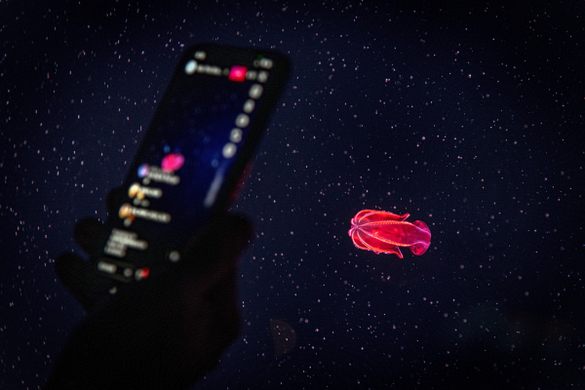AO Edited
Into The Deep/En lo Profundo Exhibit at Monterey Bay Aquarium
Enormous crabs, bioluminescent jellies, and other amazing creatures from the ocean’s depths—some of which are in an aquarium for the first time ever.
We know more about the surface of Mars than we know about the deep sea, you may have heard people say. That’s not just NASA bragging. While the deep sea is the largest ecosystem on the planet, we know very little about it. It was once thought to be completely devoid of life, which couldn’t be further from the truth. But because the deep sea is frigidly cold, totally dark, and, well, deep, it’s extremely difficult to access. The challenges in collecting and caring for deep-sea animals meant that most of the humans to see them were scientists and eccentric millionaires with access to special submarines. Now, thanks to years of work by the Monterey Bay Aquarium, all that has changed.
The Aquarium, along with MBARI – the Monterey Bay Aquarium Research Institute – has figured out how to care for creatures from the deepest depths of the ocean. The result is a new exhibit called Into The Deep/En lo Profundo that houses the largest collection of deep-sea animals in North America. Into The Deep showcases remarkable animals collected from all over the world, including from the Monterey Canyon, an underwater valley that’s twice as deep as the Grand Canyon.
Some of the animals displayed in Into The Deep are so new to science they don’t even have formal names yet, and the technology used to keep them alive is employed nowhere else on the planet. The water in the tanks is kept at an icy 40 degrees, the oxygen level is a fraction of that atop Mount Everest, and a special circulation system keeps the gelatinous, tissue-thin invertebrates, who live in an ocean without hard surfaces, from colliding with the walls of their acrylic tanks and disintegrating on contact. (The only thing not extreme about the exhibit is the water pressure. While the pressure of the deep sea is very high, the safety risk of that much pressurized water would have been too great, the viewing windows too tiny, and the animals displayed thrive at surface pressure when properly acclimated.)
The deep sea is a hugely diverse place. It has hydrothermal vents, underwater mountains, and vast, muddy plains. The life found there contains just as much variety. There are giant isopods, which are basically roly-poly bugs blown up to the size of a bread loaf. Scientists think they grow that large to endure the crushing water pressure and the cold. Anemones abound on the seafloor, too, including the apple anemone, which can swim away to safer waters when disturbed. In a scene out of a nightmare, giant sea spiders use their proboscis to suck the juices out of soft-bodied prey. Bone-eating worms and enormous spider crabs feast on whalefall, or dead whales that fall from the sunlit ocean far above.
The exhibit features bloody-belly comb jellies on display for the first time ever. These jellies have bright red bodies and stomachs that are invisible to predators—in their natural habitat, their red coloring blends in with the dark sea and may help mask any bioluminescent prey they eat. That’s a useful quality, since an estimated 75 percent of deep-sea animals have the ability to produce their own light.
As awe-inspiring as these animals and this ecosystem are, they’re also at risk from human activities. The exhibit raises awareness of the threats they face, from microplastic pollution to overfishing, underwater mining to climate change warming the global ocean. Though it may seem otherworldly, the deep sea is part of Earth. The health of the planet – and our own survival – is deeply rooted in the health of this vast, mysterious ecosystem.
Know Before You Go
Reserve your date-specific tickets in advance on the Monterey Bay Aquarium website (tickets are not available for purchase in-person).
The aquarium is open 10 a.m. to 5 p.m. every day except December 25. Your ticket allows you to arrive anytime up to an hour before closing; re-entry is permitted with a hand stamp. A passenger drop-off zone is located near the Aquarium entrance, and metered parking, garages, and parking lots are available nearby. Into The Deep is located on the aquarium’s first floor.


















Follow us on Twitter to get the latest on the world's hidden wonders.
Like us on Facebook to get the latest on the world's hidden wonders.
Follow us on Twitter Like us on Facebook